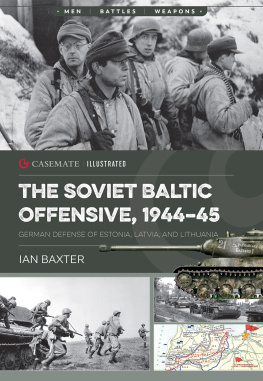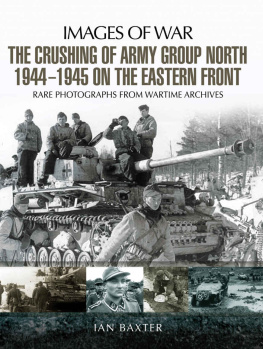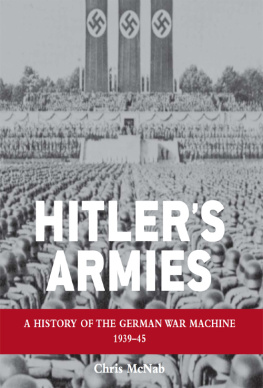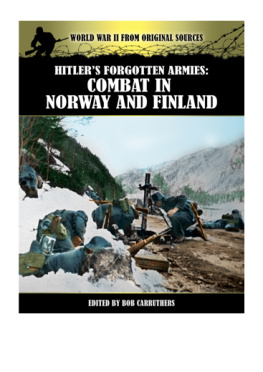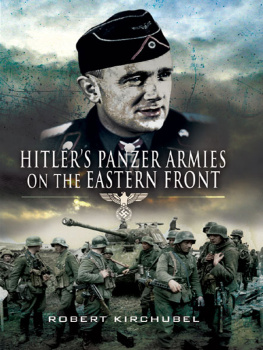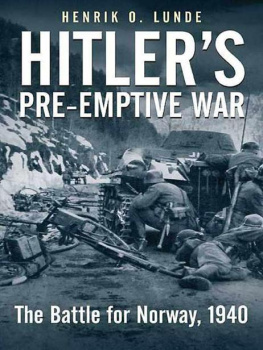
Published in the United States of America and Great Britain in 2013 by
CASEMATE PUBLISHERS
908 Darby Road, Havertown, PA 19083
and
10 Hythe Bridge Street, Oxford, OX1 2EW
Copyright 2013 Henrik O. Lunde
ISBN 978-1-61200-161-6
Digital Edition: ISBN 978-1-61200-162-3
Cataloging-in-publication data is available from the Library of Congress and
the British Library.
All rights reserved. No part of this book may be reproduced or transmitted in
any form or by any means, electronic or mechanical including photocopying,
recording or by any information storage and retrieval system, without permission
from the Publisher in writing.
10 9 8 7 6 5 4 3 2 1
Printed and bound in the United States of America.
For a complete list of Casemate titles please contact:
CASEMATE PUBLISHERS (US)
Telephone (610) 853-9131, Fax (610) 853-9146
E-mail:
CASEMATE PUBLISHERS (UK)
Telephone (01865) 241249, Fax (01865) 794449
E-mail:
CONTENTS
T he idea for this book goes back several decades, to when I was a student at the US Command and General Staff College in Fort Leavenworth, Kansas. I became curious about the question of how and why the better part of three German army groups became pinned against the Baltic Sea towards the end of World War II, and thus not available for the final defense of Germany.
I discovered in my initial exploration and numerous subsequent visits to the National Archives while stationed in Washington, D.C., and Carlisle Barracks, Pennsylvania, that it was an exceedingly complex issue, thoroughly interrelated with other subjectsparticularly those pertaining to the German northern theater of operations. While I took copious notes, I decided not to attempt to do anything more on the subject until I had more free time. Several folders containing some of those old notes were de stroyed or damaged to the point of being virtually unreadable when our home in Florida was flooded in a storm in March 1993.
The free time I was looking for took a long time coming since I entered the business world following my retirement from the US Army. When spare time finally appeared, I concentrated first on writing about the German operations in Norway and Germanys co-belligerency with Finland. This had the great advantage of making me familiar with many of the issues involved in the withdrawal from Leningrad. In addition, several articles written over the past few years also focused on the German northern theater of operations or on operations on the Eastern Front. I have been able to use much of the research that went into the earlier books and articles in this project.
I was also intrigued by the excellent and thought-provoking writings of Professor Howard D. Grier in his 2007 book. Although I arrive at different conclusions, I have relied on his research throughout this work. As in the past, I have depended on the research of Earl F. Ziemke on the German northern and eastern theaters of war. I learned a long time ago to trust the accuracy of his meticulous research. Finally, a number of outstanding books have appeared in the last decades that made my research much easier than it would have been in the 1970s. I have also used several works in Swedish and German that have not been translated into English.
It is hoped that this book, by building on the research of others, will provide useful information for the student of military history on a confusing and controversial part of World War II, the outcome of which had profound consequences. I owe a special debt to those who have written about World War II on the Eastern Frontespecially covering the last two years of that warand they are frequently referenced in text and notes.
I am grateful to a number of libraries and archives. I wish to give a very belated thanks to the extremely helpful staff at the National Archives. After all these years, I dont recall any names but they went to great length to help this novice find what he was looking for. When in doubt about what to look for and where, they gently steered me in the right direction. I also want to give specific mentions to the staff of the Coyle Free Library in Chambersburg, Pennsylvania, and the Collier County Library system in Naples, Florida. The friendly and helpful staff at these two library systems worked tirelessly to locate references, some of them rather obscure, which were then provided to me through the excellent interlibrary loan program.
I am very grateful to my old friend Dr. Enoch Haga in California, who has again offered invaluable assistance. He has tirelessly served as an editor and advisor for every part of the book. Dr. Haga provided many helpful suggestions and gave encouragement whenever I encountered seemingly insoluble problemsand that was quite often. Dr. Loislane Lowe, also in California, has also assisted in the proofing and editorial process.
I am also grateful to the Publisher, Mr. David Farnsworth, and his excellent staff at Casemate for showing confidence in me by accepting this book for publication and also for their assistance by taking over the map making and photo selection chores when it became obvious that I was going to encounter problems in meeting the publication schedule because of major events in my own life. I am particularly grateful to Mr. Steven Smith, the Editor Director, and to Ms. Tara Lichterman, my point of contact, who patiently listened to my many gripes and cleared administrative hurdles.
Finally, it is obvious that this work could not have been completed with out the understanding and support of my immediate family members. My debt to them is immense. My wife Florence died on June 3, 2012, as I was in the middle of writing this book. For almost 50 years she was loyally at my side through good and bad times. Knowing of my deep interest in military history, her encouragement was a driving force in my writing. This book is therefore dedicated to her.
Despite the diligence of those who provided assistance, comments and advice, I must stress that I take full responsibility for all conclusions and such errors as this book may inadvertently contain.
NOTES
. | Howard D. Grier, Hitler/Dnitz and the Baltic Sea: The Third Reichs Last Hope, 19441945 (Annapolis: Naval Institute Press, 2007) |
I n order to examine and hopefully understand Hitlers decision to defend the Baltic States at all costs this book attempts to tackle five exceedingly complicated and interrelated subjects:
1. Military strategy;
2. Hitlers strategic thinking;
3. The progressive changes in the military environment, especially those involving the opposing forces on the Eastern Front;
4. Hitlers fascination with the northern theater of war, including both Scandinavia and the Baltic region;
5. The validity of the reasons given by Hitler for refusing to withdraw in the Baltic.
The many reasons given by Hitler for his rigid forward defense in the Baltic States include:
1. Fear that a withdrawal would lead Finland to make a separate peace with the Soviets. The loss of Finland could lead to:
a. The entrapment of the German Twentieth Mountain Army in northern Finland;
b. The loss of the nickel supply from Finland;
c. Breakout of the Soviet Baltic Fleet from Kronstadt, which would endanger German naval control of the Baltic and jeopardize the transport of iron ore and finished products from Sweden.
2. The threat to the submarine training area from both east and west.
3. Swedish intervention in the war on the side of the Allies. This outcome would:
a. End the transit of German troops through Sweden;
Next page



